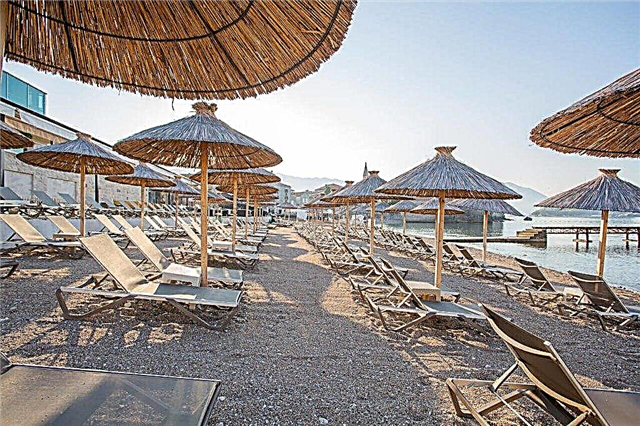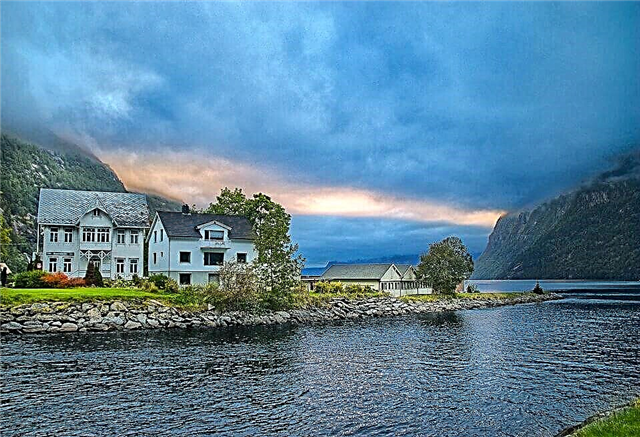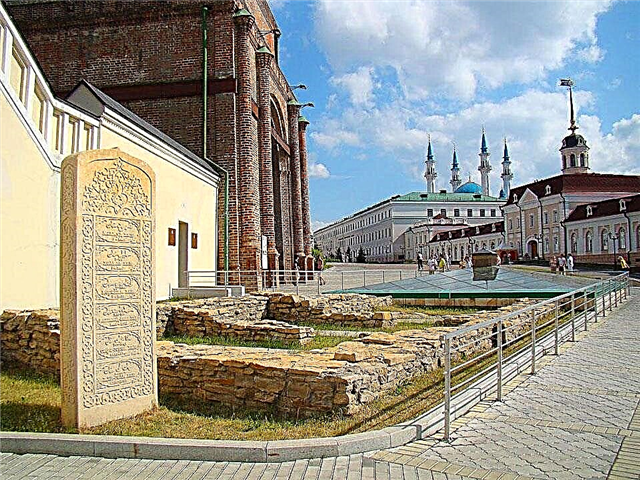Address: Russia, St. Petersburg, Pushkin, Tsarskoe Selo
Area: about 200 hectares
Main attractions: Alexander Palace, Big Chinese Bridge, Cross Bridge, Chinese Village, Big and Small Whims, White Tower, Chapelle Pavilion, Arsenal Pavilion, Krasnoselsky Gate, Children's House, Dragon Bridge
Coordinates: 59 ° 43'15.7 "N 30 ° 22'38.5" E
Content:
The large green park in Tsarskoe Selo covers an area of 200 hectares. They began to equip it at the end of the 18th century, simultaneously with the construction of the Alexander Palace. Tourists come to picturesque alleys to feed squirrels, watch birds, climb to the top of the Parnassus mound and admire the ancient pavilions.

View of the Alexander Park and the Alexander Palace
History of the park
The area where the park is located rises 65 m above sea level. Once upon a time it was covered with pine and spruce forests and lowland swamps. Until 1702, the Swedish estate Sarskaya manor was located here. A small wooden house and outbuildings surrounded the garden, and straight alleys divided it into four equal squares.
In the 1720s and 1730s, the Tsar's Menagerie was organized in a fenced area of the forest to the west of the Catherine Palace. Boars, elks and hares were kept here for the imperial hunting. Since there were few natural reservoirs and streams in the park, channels were laid along it and ponds were created. Then the first pavilions and artificial ruins appeared in the glades among the trees.

Cross bridge
Palace buildings and green spaces were badly damaged during the years of the Nazi occupation. The restoration of ancient pavilions, bridges and sculptures took many years. Some of them remain in ruins until sire. Today Alexander Park, like all Tsarskoe Selo, is included in the list of UNESCO World Heritage Sites.
New garden
The regular part of the Alexander Park is adjacent to the Great Catherine Palace. It is distinguished by a rectangular layout of alleys, pools and flower beds, therefore it is very similar to the French palace parks of the 17th-18th centuries.

Chapelle Pavilion
The history of the New Garden began in 1740, when a regular park began to be laid out on the site of the Tsar's Menagerie. All works were supervised by Empress Elizabeth Petrovna. She personally hired gardeners and strove for them to embody the most daring landscape ideas next to her palace.
Today, one of the entrances to the New Garden is the Great Chinese Bridge. A beautiful building made of pink granite appeared in 1785 by the architect Charles Cameron. Initially, it was decorated with figures of four Chinese, but when the limestone sculptures deteriorated, they were replaced with zinc ones.
The original Cross Bridge is laid to the south. It consists of four granite stairs that lead to an elegant Chinese gazebo. The walls of the building are cut with lancet windows and finished with multi-colored glazed bricks.

Arsenal Pavilion
Through the regular part of the park, there is a straight Linden Alley, which forms the main axis of the New Park. Perpendicular glades divide the forest area into four equal parterres, and they are surrounded by the Krestovy Canal. At the far end of the Linden Alley is the Dragon Bridge, which was also designed by the talented architect C. Cameron. The ancient bridge is decorated with cast-iron figures of winged dragons sitting on massive granite pedestals.
The highest part of the Aleksandrovsky Park is occupied by a bulk mound, which is called Mount Parnassus. Tourists climb up the spiral road. In summer, the top of the artificial hill is almost entirely obscured by shady tree crowns.
The center of the neighboring park square is occupied by the ruins of the Chinese theater. This exotic building in oriental style was erected in the 80s of the 18th century according to the project of Antonio Rinaldi. Under Catherine II, Nicholas I and Nicholas II, performances and operas were performed here. During the shelling in the fall of 1941, the unique building was left without a roof and burned out from the inside.

White Tower
Closer to the Catherine Palace there is an unusual curtain "Mushroom". It got this name because of the gazebo with a mushroom-like roof. Today, not a trace remains of the old building. A round meadow has been preserved in the center, and eight straight alleys extend from it.
To the south of the curtain is a Chinese village. It appeared during the reign of Catherine II and is now fully restored. Stylized houses with bright curved roofs have been transformed into luxury apartments where foreign specialists live.
Nearby you can see the Big Caprice park building. This is an artificial stone mound with arched spans. A small Chinese-style pink marble gazebo rises on a stone wall.

Big whim
Landscape park
At the end of the 18th century, the fashion for strict French parks faded away and was replaced by a fascination with English parks with free landscape planning. A picturesque landscape park has appeared next to the New Garden. Today it occupies most of the Aleksandrovsky Park. There are many unique structures and architectural monuments here, but visitors visit this part of the green zone much less often than the square parterres outlined by the Krestovy Canal.
There are several ponds near the Alexander Palace. One of them shows an island with a Children's House. A small blue pavilion was built for the children of Emperor Nicholas I in 1830. Inside there was a living room and several simply decorated rooms for entertainment and games. The emperor's children were taken to the island by ferry and rowboat. At the end of the 19th century, burials of royal dogs appeared next to the pavilion. Today the Children's House needs restoration and is closed to visitors.

On the Great Chinese Bridge
To the north of the palace, behind the ponds, the five-story White Tower rises. The sons of Nicholas I used it for war games and exercises. Now the tower houses a children's museum center.
On the southern edge of the landscape park, the Chapelle pavilion flaunts. It was built in 1828 and looks like a partially destroyed Gothic chapel. The restoration of the pavilion was completed in 2018, so many tourists come to see it.
Straight alleys and winding paths converge in the center of the park near the majestic Arsenal. The construction of the red brick pavilion was completed in 1834. The building with towers is stylized as a medieval castle with loopholes. Today in the restored Arsenal there is a permanent exhibition of tsarist weapons, and nearby there is a stone Grotto-spring.

Chinese village
To the north is the Pensioner Stable. The history of this park building began in 1826, when Nicholas I ordered the transfer of several riding horses from St. Petersburg to Tsarskoe Selo. A two-storey pavilion was built especially for the animals living out their days. The grooms and the caretaker were upstairs, and old horses occupied the first floor of the building.
It is interesting that near the old tsar's stable there is a cemetery of imperial horses, which were ridden by Russian sovereigns from Alexander I to Nicholas II. The burial places are marked with rectangular stone slabs.
In the north of the park is the brick Imperial Farm. Since 1828, she served the royal court and selected the best breeds of cattle for breeding in Russia. The farm was inhabited by a veterinarian and cattlemen, had its own oil mill and a glacier. Surplus products - butter and milk were sold to everyone. The best preserved buildings are the cowshed and the caretaker's house. Today it houses the equestrian complex of the museum-reserve.

Children's house
To the east of the farm, you can see a monument of the neo-Russian style - the War Chamber.The picturesque complex was built during the reign of Nicholas II - at the beginning of the last century. The structure is an irregular polygon and consists of buildings and towers with 2-3 floors. The architect Semyon Sidorchuk used the medieval buildings of Pskov and Novgorod as a prototype. Now the only museum of the First World War in our country operates in the War Chamber.
Useful information for visitors
The territory of the Alexander Park is fenced. You can enter it from two sides. From the north, the park is entered from the Alexander Palace. Many tourists use the Great Chinese Bridge to enter, which is located to the west of the Great Catherine Palace. Admission is free, but not around the clock. The territory is open on any day except Tuesday: in the summer from 7:00 to 22:00, and in the off-season and in winter from 10:00 to 18:00.

Dragon bridge
How to get there
The park is located in the city of Pushkin, 25 km south of St. Petersburg. It is convenient to get to Tsarskoe Selo by electric trains, which depart from Vitebsk and Baltic railway stations. From the Tsarskoe Selo station, tourists take a bus or fixed-route taxi and get to the Dvortsovaya Ulitsa stop. Buses to Pushkin run from the metro stations Moskovskaya, Kupchino, Moskovskaya and Zvezdnaya.











